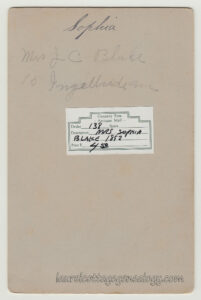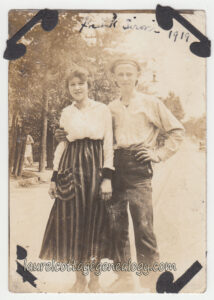

Cabinet Card, 1892. Photographer: McIntosh & Allen. Gardiner, Maine.
Price: $20.00 Size: About 4 and 1/4 x 6 and 1/2″
An adorable expression…..
If the date on the back is accurate, Sophia would have been about fifty in this photo.
She has accessorized here with a brooch fixed to a white lace collar, matching earrings (though only one is visible) and that’s perhaps a lace or net-type fabric head covering with fabric rosettes making her hair look a bit shaggy. (It only adds to the charm.) I’m picturing her with a good sense of humor.
Details….
Sophia Jane McIntosh was born September 3, 1842 in Hallowell, Kennebec, Maine, daughter of George W. and Hannah (Bayer) McIntosh. She was twice married. First to George William Webber, March 25, 1858, whom she divorced in October 1867. They had two daughters, Sarah, born 1858 and Alice, born 1861. She married Jeremiah Curtis Blake July 31,1870. He was born in Maine, about November 1846, and from the 1900 Federal Census for Winthrop, Massachusetts, his occupation was policeman.
Find A Grave lists Sophia’s maiden name as MacIntosh, though other records, including her birth record and her parents’ marriage record show McIntosh. You’ll have noticed the photographer’s surname is the same – it appears he and Sophia were brother and sister. (Rather a nice find!) Sophia died August 22, 1926 in Winthrop, Massachusetts.
The photographers….
No reference was found for McIntosh & Allen, and nothing for Allen in Gardiner, or its county, Kennebec. (Turn your head sideways slightly to see catch the “&” sign!)
McIntosh was George F. McIntosh, born April 26, 1849, Hallowell, Maine; and as indicated above, son of George W. McIntosh and Hannah (Bayer) McIntosh, and sister of Sophia. He married Elizabeth Blanchard in 1872 and they had five children. Sometime between the 1870 and 1880 Federal Census’ he went into the photography business. It’s unclear whether he may have had more than one studio at a time; records show him in various cities and towns: Hallowell, Gardiner, Augusta and Richmond Township, Maine; Laconia and Dover, New Hampshire and Lynn, Massachusetts. The 1920 census in Laconia lists him as retired, however, a Hallowell city directory in 1923 has him still working. He died June 2, 1931 in Hallowell.
One last note….
This cabinet card was found at the Cannery Row Antique Mall in Monterey, California. It’s unknown who may have given the 1892 card date and without knowing, one wonders if it’s exact or more of a guess, though the 1892 city directory does confirm Gardiner, Maine for George F. McIntosh, photographer. As for the address penciled on the back of the card: 15 Ingleside Avenue was in Winthrop, Mass on the 1910 census but was 5 Ingleside on the 1900. (Maybe an error on the earlier census or a renumbering situation on the later.)
Sources: Find a Grave, database and images (https://www.findagrave.com/memorial/124584840/sophia-jane-blake: accessed 28 November 2023), memorial page for Sophia Jane MacIntosh Blake (Sep 1842–22 Aug 1926), Find a Grave Memorial ID 124584840, citing Winthrop Cemetery, Winthrop, Suffolk County, Massachusetts, USA; Maintained by Bob McLellan (contributor 47824019).
Ancestry.com. Maine, U.S., Compiled Marriages for Belfast, Hallowell and Pittsdon, 1748-1875.
Ancestry.com. Maine, U.S., Divorce Records, 1798-1891.
Find a Grave, database and images (https://www.findagrave.com/memorial/100617756/george-f-mcintosh: accessed 30 November 2023), memorial page for George F. McIntosh (1849–1931), Find a Grave Memorial ID 100617756, citing Hallowell Village Cemetery, Hallowell, Kennebec County, Maine, USA; Maintained by Maine 101 (contributor 47130320).
Maine State Archives; Cultural Building, 84 State House Station, Augusta, ME 04333-0084; Pre 1892 Delayed Returns; Roll Number: 73. (Ancestry.com).
Year: 1870; Census Place: Hallowell, Kennebec, Maine; Roll: M593_546; Page: 325A. (Ancestry.com).
Year: 1880; Census Place: Hallowell, Kennebec, Maine; Roll: 481; Family History Film: 1254481; Page: 277B; Enumeration District: 096. (Ancestry.com).
Year: 1900; Census Place: Winthrop, Suffolk, Massachusetts; Roll: 690; Page: 22; Enumeration District: 1577. (Ancestry.com).
Year: 1910; Census Place: Winthrop, Suffolk, Massachusetts; Roll: T624_626; Page: 1a; Enumeration District: 1691; FHL microfilm: 1374639. (Ancestry.com).
Year: 1920; Census Place: Hallowell, Kennebec, Maine; Roll: T625_643; Page: 11A; Enumeration District: 61. (Ancestry.com).
Ancestry.com. U.S., City Directories, 1822-1995.


























